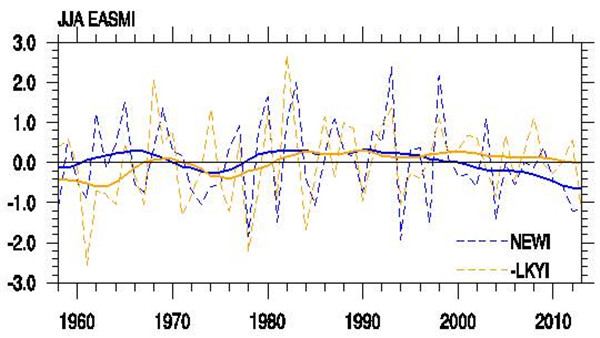IAP Scientists Proposed a New Upper-level Circulation Index for the East Asian Summer Monsoon Variability
Date:2015-11-12
The East Asian summer monsoon (EASM) is one of the most energetic components of the earth’s climate system during boreal summer. The variability of the EASM has substantial social and economic influences. Still, it is a great challenge to predict the EASM and associated climate features accurately. Index is an important tool for the study of the EASM. Although many indices have been proposed to depict the characteristics of the EASM and its associated climate, these indices have limitations because the regions for variables used to define the indices do not cover fully the domain of the EASM systems.
EASM and its variability involve circulation systems in both tropics and mid-latitudes as well as in both lower and upper troposphere. Considering this fact, a new EASM index (NEWI) is proposed by scientists from Institute of Atmospheric Physics based on 200hPa zonal wind. The NEWI can capture the inter-annual EASM-related climate anomalies and the inter-decadal variability well. Compared to previous indices, the NEWI shows a better performance in describing precipitation and air temperature variations over East Asia. It can also show distinct climate anomalous features in early and late summer. The NEWI is tightly associated with the East Asian-Pacific or the Pacific-Japan teleconnection, suggesting a possible role of internal dynamics in the EASM variability. Meanwhile, the NEWI is significantly linked to El Ni?o-Southern Oscillation and tropical Indian Ocean sea surface temperature anomalies. Furthermore, the NEWI is highly predictable in the ENSEMBLES models, indicating its advantage for operational prediction of the EASM. The physical mechanism of the EASM variability as represented by the NEWI is also explicit.

Fig. 1 (a) Latitude-height cross section showing regression anomalies (color) of zonal wind averaged between 105°–150°E against JJA mean Meiyu-Changma-Baiu rainfall, (b) regression anomalies (color) of 200hPa zonal wind against JJA mean Meiyu-Changma-Baiu rainfall, (c) the first EOF mode of JJA mean 200hPa zonal wind anomalies (color). The red dots indicate the 95% confidence levels based on a two-sided Student’s t test. The unit is m s-1 for zonal wind. The wireframes indicate the areas used to define the NEWI. The time period is 1958–2013. (Zhao and Huang, 2015)

Fig. 2 Normalized JJA mean EASMI (dashed line) and 11-years running average (solid line) for the period 1958–2013. The blue line is for the NEWI and the orange line for the reversed LKYI. (Zhao and Huang, 2015)
Both warm advection anomalies of temperature by anomalous westerly winds and the advection of anomalous positive relative vorticity by northerly basic winds cause anomalous ascending motion over the Meiyu-Changma-Baiu rainfall area, and vice versa over the South China Sea area. Hence, this NEWI would be a good choice to study, monitor, and predict the EASM; Meanwhile, this index can be used in the study of the ancient climate, model evaluation, and the future forecast of monsoon.
Reference:
Zhao, G., G. Huang, R. Wu, W. Tao, H. Gong, X. Qu, and K. Hu, 2015: A New Upper-level Circulation Index for the East Asian Summer Monsoon Variability. J. Climate. doi:10.1175/JCLI-D-15-0272.1, in press.
Contact: HUANG Gang, hg@mail.iap.ac.cn
